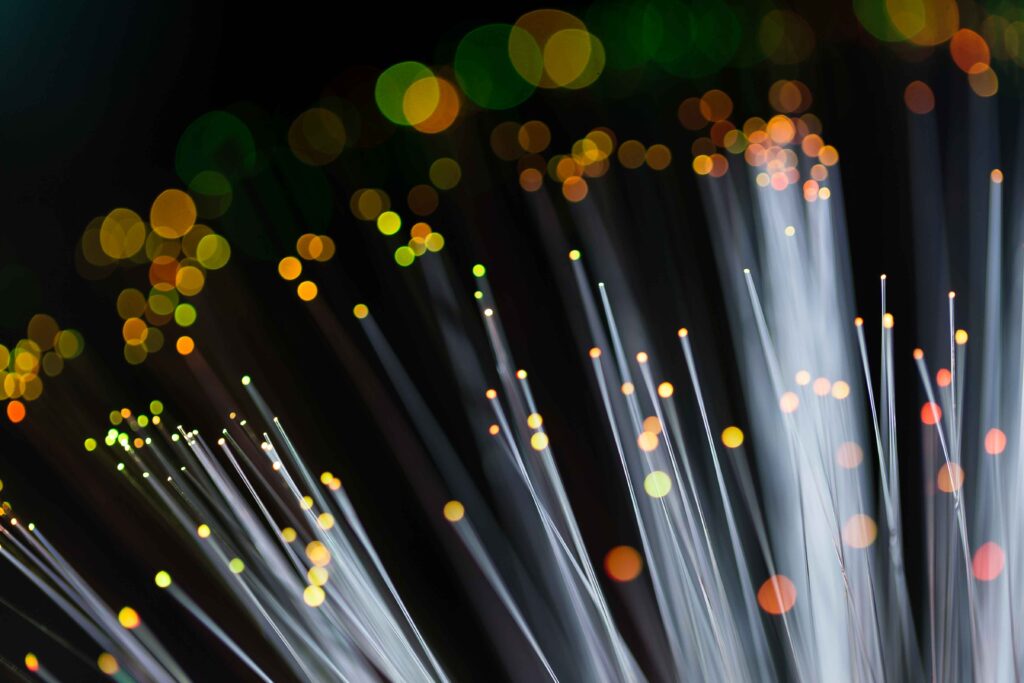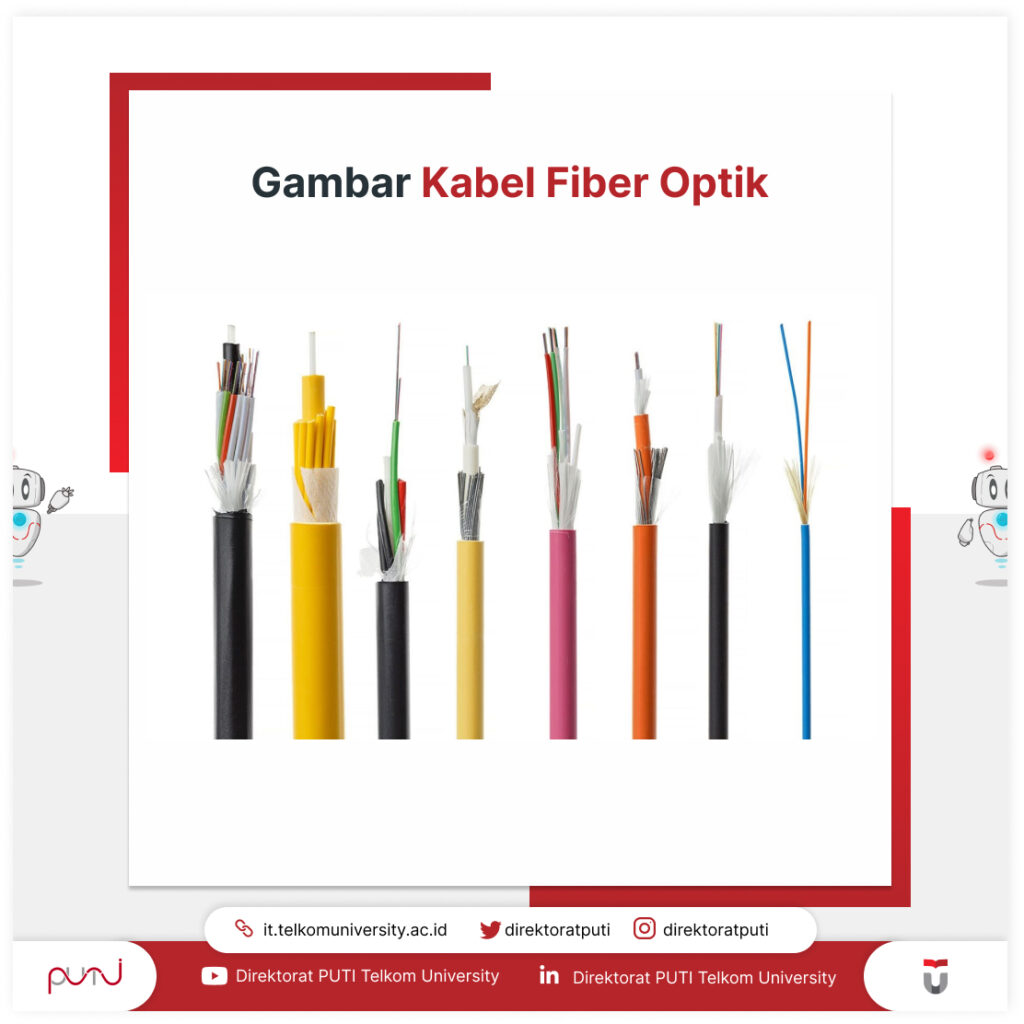
Get to Know More About Fiber Optic Technology And Its Application
Optical Fiber is a transmission medium that functions to send data or information via glass fiber with greater speed and bandwidth compared to copper cable technology.
Getting to know Fiber Optic Cables
Fiber optics is a technology used to transmit information in the form of light signals through very thin and transparent optical fibers. Optical fibers consist of a very small core surrounded by a protective layer called a coat. These fibers are usually made of glass or special plastic that has a high refractive index, allowing light to continue to be trapped in them and continue to propagate through the fiber.
Basically, the way optical fiber works is by utilizing a law of physics called “total internal reflection”. When light enters an optical fiber at a certain angle, it will reflect within the fiber at the same or smaller angle, so that the light can continue to move forward without much energy loss.
The data signal is encoded into the form of light pulses or variations in light intensity, which are then transmitted via optical fiber. This light can move very quickly and carry large amounts of data, so optical fiber is often used in long-distance telecommunications communications, such as telephone networks, the internet, cable television and computer networks.
Fiber Optic Cable Image
Look at the following picture of a fiber optic cable, in general it consists of 3 main layers, namely Core , Cladding and Coating
Core (Core)
Fiber Optic Core is the deepest part of a fiber optic cable, which is protected by Cladding and Coating . Fiber Optic Core is the place where light propagates and experiences reflection. The core is often made of special glass or plastic with a high refractive index. In single-mode cables , the core has a very small diameter, while in multi-mode cables , the core has a larger diameter. Core Refractive Index (Core) > Mantle Refractive Index (Cladding) This functions to ensure that light passing through the core will continue to be reflected so as to avoid the possibility of losing data signals while on the way to sending information.
Mantle (Cladding)
Cladding is the middle layer of fiber optic cable that covers the core . Its function is to reflect light back into the core with the principle of total internal reflection, so that the light remains concentrated in the core and is not scattered. Cladding has a different refractive index value than the core.
Protective (Coating)
Coating is the outer layer that protects the core and mantle from physical damage and the external environment. This protector is made of strong material and is resistant to pressure, moisture and mechanical damage. The protector is often an outer layer made of plastic or Kevlar fiber which provides additional strength.
What are the Functions of Optical Fiber
The following are some of the functions of optical fiber in various industries, including:
Telecommunications Communications
The main function of optical fiber is as a transmission medium for telecommunications communications. Optical fiber is used in telephone networks, internet networks, cable television networks, and other data communications networks. Optical fiber enables the transmission of large amounts of data at high speed over optical fiber, enabling efficient and reliable long-distance communications.
Computer network
Optical fiber is also used in computer networks to connect network devices such as switches, routers and servers. Fiber optic cables are used to transmit data between these devices with high speed and high reliability.
Broadcasting Industry
In the broadcasting industry, fiber optics are used to transmit audio, video and data signals between production centers and television or radio stations. Optical fiber provides high quality and high reliability in transmitting these signals, and allows broadcasting in high resolution (HD) and ultra-high definition (UHD).
Sensory
Optical fibers are used in various sensory applications, such as pressure sensors, temperature sensors, speed sensors, and so on. Optical fibers function as sensitive elements in these sensors, with changes in light occurring within the fiber used to detect and measure physical parameters.
Lighting
Fiber optics are used in decorative lighting and architectural lighting. Optical fibers, called beam optical fibers, are used to deliver light from a central light source to the place you want to illuminate, such as a garden, building, or other objects. Fiber optic lighting can provide interesting light effects and flexibility in lighting design.
Medical Field
Fiber optics are used in the medical field for applications such as endoscopy and minimally invasive surgery. Flexible optical fibers are used to transmit light into the patient’s body, allowing doctors to see and perform medical procedures with high accuracy and precision.
Apart from that, optical fiber also has various applications in the fields of security, industrial control systems, measurements and instruments, oil and gas drilling, as well as in the manufacture of sensors and other optical devices. The functions and applications of fiber optics continue to develop along with technological advances and the increasing need for fast and reliable data transmission.
Advantages and Disadvantages of Optical Fiber
The following are some of the advantages and disadvantages of fiber optic cables, among others
Excess
High speed
Optical fiber is capable of transmitting data at very high speeds. Optical fiber has a large bandwidth capacity, so it can transmit large amounts of data at gigabit or terabit speeds per second. This speed enables fast and responsive data transfer in telecommunications communications, computer networks, and other applications.
High Capacity
Optical fiber has a much greater capacity than conventional copper cables. A single optical fiber can accommodate multiple communication channels simultaneously. This allows for denser data transmission and minimizes the use of physical infrastructure.
Long Transmission Distance
Optical fiber has excellent long-distance transmission capabilities. Light signals in optical fibers experience less energy loss compared to electrical signals in copper cables. Therefore, fiber optics can transmit signals up to thousands of kilometers without loss of quality and speed. This makes it ideal for use in long-distance telecommunications networks, including undersea routes.
Lack
High Initial Installation Costs
Fiber optic installation costs are higher than conventional copper cables. Optical fiber requires special equipment and high technical skills for installation and welding of optical fiber. This can lead to higher initial costs, especially if the installation is done on a large scale.
Susceptibility to Mechanical Damage
Although optical fibers are quite resistant to pressure and pulling, they can be damaged if bent or pulled hard. Construction work or accidents such as unauthorized excavation can cause damage to optical fibers. This may result in data transmission failure and require additional time and costs to repair.
Difficult Maintenance
If there is damage to the optical fiber, maintenance and repair usually require specialized technical expertise. The welding and testing process requires special equipment and special training. This can slow down repair times and increase maintenance costs.
Types of Optical Fiber
There are several types of optical fiber that are commonly used in various applications. Following are some of the main types of fiber optics:
Single-mode (SM) Optical Fiber
This type of optical fiber is designed to transmit light in one mode or single light path. The optical fiber core in single-mode fiber is very small, usually around 9 microns, which allows for more directional light propagation. Single-mode fiber is used to transmit signals over long distances and high speeds, such as in long-distance telecommunications networks and network backbone applications .
Multi-mode (MM) Optical Fiber
This type of optical fiber is designed to transmit light in several different modes or light paths. The optical fiber core in multi-mode fiber is larger than single-mode fiber, usually ranging from 50 to 62.5 microns. Multi-mode fiber is used over short to medium distances, such as in Local Area Networks (LANs), building installations, and broadcasting systems.
Optical Fiber Step-Index
This type of optical fiber has a sharp refractive index difference between the fiber core and the coat. Light propagates in these optical fibers by reflecting at the boundary between the core and the mantle. Step-index fiber is used over short to medium distances and can be used for both single-mode and multi-mode .
Graded-Index Optical Fiber
This type of optical fiber has a refractive index that varies gradually from the center of the core to the mantle. This results in a smoother change in the speed of light as it travels through the fiber. Graded-index fiber allows for better mode dispersion, which reduces signal distortion . This optical fiber is generally used over short to medium distances in data communications applications and computer systems.
Plastic Optical Fiber (POF)
POF uses optical fibers made of special plastic instead of glass in conventional optical fibers. POF has a larger core and uses infrared red light as a light source. POF is commonly used in short-range applications such as in local networks (LAN), automotive systems, audio devices, and decorative lighting.
Apart from that, there are also other variations and modifications of optical fiber, such as Polarization-Maintaining Fiber (PMF) which maintains the polarization orientation of light, Double-Clad Fiber which is used in laser applications, and Hollow-Core Fiber which uses a hollow core to transmit light through air or gas. Each type of optical fiber has its own characteristics and uses depending on the specific application needs.
Source :
https://www.techtarget.com/searchnetworking/definition/fiber-optics-optical-fiber
Author: Hassan Rizky Putra S | Editor : Meilina Eka Ayuningtyas

